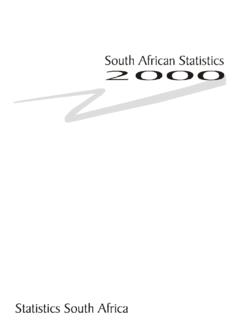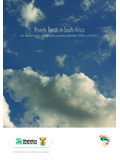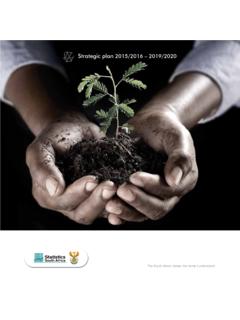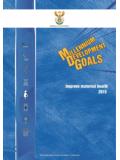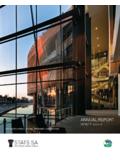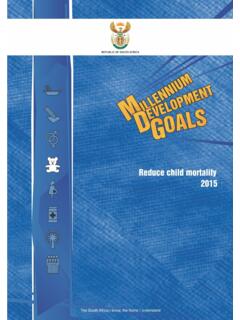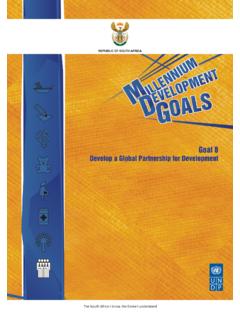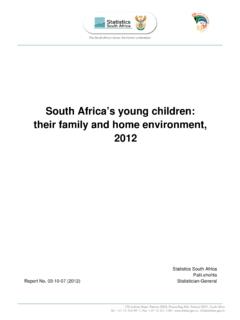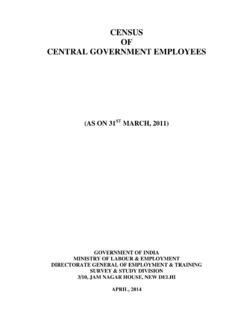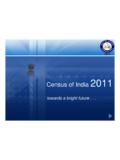Transcription of 29 OCTOBER CENSUS 2011 Release P0301.4 28 Oct 2012 …
1 THE SOUTH AFRICA I KNOW, THE HOME I UNDERSTANDS tatistical releaseDe Bruyn Park Building, 170 Thabo Sehume Street, Pretoria, 0002 Private Bag X44, Pretoria, 0001, South AfricaUser information service: +27(12) 310 8600, Fax: +27(12) 310 8500 Main switchboard: +27(12) 310 8911, Fax: +27(12) 321 7381 Website: , Email: Statistical Release CENSUS 2011 Embargoed until:30 OCTOBER 2012 10:00 Enquiries: Angela Ngyende Tel. (012) 310 4699 Statistics South Africa CENSUS 2011 Statistical Release CENSUS 2011 Statistical Release / Statistics South Africa Published by Statistics South Africa, Private Bag X44, Pretoria 0001 Statistics South Africa, 2012 Users may apply or process this data, provided Statistics South Africa (Stats SA) is acknowledged as the original source of the data; that it is specified that the application and/or analysis is the result of the user's independent processing of the data.
2 And that neither the basic data nor any reprocessed version or application thereof may be sold or offered for sale in any form whatsoever without prior permission from Stats SA. Stats SA Library Cataloguing-in-Publication (CIP) Data CENSUS 2011 Statistical Release / Statistics South Africa. Pretoria: Statistics South Africa, 2012 83 pp A complete set of Stats SA publications is available at Stats SA Library and the following libraries: National Library of South Africa, Pretoria Division National Library of South Africa, Cape Town Division Library of Parliament, Cape Town Bloemfontein Public Library Natal Society Library, Pietermaritzburg Johannesburg Public Library Eastern Cape Library Services, King William s Town Central Regional Library, Polokwane Central Reference Library, Nelspruit Central Reference Collection, Kimberley Central Reference Library, Mmabatho This publication is available on the Stats SA website.
3 For technical enquiries please contact: Calvin Molongoana Tel: 012 310 4754 Fax: 012 310 4865 Email: For dissemination enquiries please contact Printing and Distribution, Statistics South Africa Ina du Plessis Email: Statistics South Africa CENSUS 2011 Statistical Release iiCautionary notes Data - Comparison of CENSUS 2011 and previous Censuses requires alignment of data to 2011 municipal boundaries Disability - Questions on disability were replaced by General health and functioning questions. Due to change in question, 2011 results are not comparable with previous Censuses 1996 and 2001. - Due to misreporting on general health and functioning questions for children younger than five years, data on this variable are only profiled for persons five years and older.
4 Labour statistics (employment) - Quarterly Labour Force Survey (QLFS) remains the official source of labour statistics - The QLFS_Q4: 2011 has not been benchmarked to CENSUS 2011 figures and the differences between the two are therefore only broadly indicative - Boundaries - provincial trends over time are difficult to establish due to changes in boundaries o CENSUS is a de facto measure of the population; while QLFS survey is a de jure measure. o The reference period in CENSUS ( CENSUS night) is fixed while it is a moving reference period over three months for QLFS - Formal and informal sector: o An objective measure is used in the QLFS based on vat/income tax registration and establishment size, a subjective measure is used in CENSUS 2011 .
5 Also, in line with ILO guidelines, persons employed in agriculture and private households are not usually included in the formal and informal sectors, but are identified as separate categories. It is not currently possible to identify agricultural employment in CENSUS 2011 , since the coding of industry and occupation has not yet been completed. Sectoral distributions therefore include persons employed in agriculture. And with regards to persons employed in private households, the results are not based on the relevant questions that determine the international classification for industry but instead are based on the question which determines the sector in which respondents were employed.
6 Thus, after coding is completed the numbers may change. Rounding off Due to rounding, the displayed totals in the tables do not always match the sum of the displayed rows or columns Statistics South Africa CENSUS 2011 Statistical Release iiiContents iii 1. INTRODUCTION ..1 Overview ..1 How the count was done ..1 Planning ..1 Pre-enumeration ..1 Data processing ..2 Data editing and validation system ..2 Editing team ..2 Role of the Editing strategy for CENSUS Independent monitoring and evaluation of CENSUS field Post-enumeration survey (PES).
7 3 Preparations for the PES ..4 Methodology ..4 Sampling ..5 Questionnaire development ..5 Fieldwork methodology ..5 Matching and reconciliation PES data Matching and reconciliation ..6 Estimation and Conclusion ..8 2. GEOGRAPHY OF SOUTH AFRICA ..9 Provincial boundary changes: 2001 to 2011 ..9 Local municipal boundary changes, 2001 2011 ..11 Comparing CENSUS 2011 with previous 3. Demographic characteristics ..14 Introduction ..14 Population Population Sex ratio.
8 17 Median age ..20 Population structure ..21 Concluding remarks ..22 Migration ..22 Introduction ..22 Patterns of migration between Censuses 2001 and Statistics South Africa CENSUS 2011 Statistical Release Life-time migration patterns ..24 Citizenship ..26 Education ..26 Introduction ..26 Attendance at an educational institution ..27 Average annual household income ..38 General health and Introduction ..41 Labour market status ..44 The labour market in South Africa ..44 Introduction ..44 National labour market results from CENSUS 2011 and the QLFS_Q4: 2011 .
9 45 Provincial labour market rates based on CENSUS 2011 and QLFS_Q4 Key labour market rates by population group, based on CENSUS Key labour market rates by sex and population group, based on CENSUS 2011 ..48 Key labour market rates by age group based on CENSUS 2011 ..50 Conclusion ..51 Housing ..52 Introduction ..52 Conclusion ..64 Mortality data: Household deaths ..64 Parental survival ..73 List of maps Map : Provincial boundary changes since 2001 ..10 Map : Municipal boundary changes since 2001 ..12 Statistics South Africa CENSUS 2011 Statistical Release 11. INTRODUCTION Overview Censuses are principal means of collecting basic population and housing statistics required for social and economic development, policy interventions, their implementation and evaluation.
10 South Africa has conducted three Censuses (1996, 2001 and 2011 ). CENSUS 2011 was the third CENSUS to be conducted since the post democratic elections in 1994 and a number of population and household attributes were measured and variety of indicators generated. This chapter provides profiles results on all CENSUS topics; demographics, migration, education, general health and functioning, labour force, mortality, and households. How the count was done CENSUS 2011 was conducted from 9th to 31st OCTOBER 2011 . This section focuses on the various activities that were carried out prior to the finalisation of the results. They can be summarised as follows: Planning, Pre-enumeration, Enumeration, Processing and Editing.

